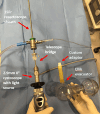Utilizing the Ellik bladder evacuator during cystoscopic retrieval of urocystoliths in 12 dogs
- PMID: 39701581
- PMCID: PMC11658828
- DOI: 10.1111/jvim.17280
Utilizing the Ellik bladder evacuator during cystoscopic retrieval of urocystoliths in 12 dogs
Abstract
Background: Urocystolithiasis is a common problem in dogs; many canine uroliths are resistant to medical dissolution. Novel management options would expand, and in some cases improve, current urolith retrieval strategies.
Hypothesis/objectives: To describe a previously unreported technique by the Ellik bladder evacuator (EE) to assist in minimally invasive, cystoscopic retrieval of canine cystoliths.
Animals: Twelve client-owned dogs presented with urocystolithiasis.
Methods: In this retrospective study, dog demographics, procedure type and duration, and clinical outcomes of dogs undergoing cystoscopic cystolith retrieval utilizing the EE are described.
Results: Twelve dogs underwent 13 cystoscopic procedures utilizing EE for cystolith retrieval. The EE was used in accordance with previously described techniques via a custom-made adaptor. Ten dogs were spayed females; 8 different breeds were represented. In 8 of 13 procedures, transurethral cystoscopy alone by EE with or without wire basket or grasping forceps was performed with a median procedure duration of 36 minutes (range, 16-52). In the other 5 procedures, additional interventions (ie, laser lithotripsy, percutaneous perineal approach, urethral stricture ballooning, ethanol parathyroid ablation) were performed as indicated with a median procedure duration 110 minutes (range, 42-144). No complications were noted in association with the use of the EE; retrieval of cystoliths was complete in 12 of 13 procedures.
Conclusions and clinical importance: Use of the EE during cystoscopy might aid in minimally-invasive retrieval of cystoliths. This work provides a starting point for additional discussion regarding its benefit relative to current interventions.
Keywords: cystoscopy; minimally invasive procedure; resectoscope; urolithiasis.
© 2024 The Author(s). Journal of Veterinary Internal Medicine published by Wiley Periodicals LLC on behalf of American College of Veterinary Internal Medicine.
Conflict of interest statement
Shelly L. Vaden serves as Associate Editor for the Journal of Veterinary Internal Medicine. She was not involved in review of this manuscript. No other authors declare a conflict of interest.
Figures


Similar articles
-
Effect of patient positioning on retrieval of cystoliths by percutaneous cystolithotomy in dogs.Vet J. 2025 Feb;309:106291. doi: 10.1016/j.tvjl.2024.106291. Epub 2024 Dec 16. Vet J. 2025. PMID: 39694454
-
Efficacy and safety of laser lithotripsy in fragmentation of urocystoliths and urethroliths for removal in dogs.J Am Vet Med Assoc. 2009 May 15;234(10):1279-85. doi: 10.2460/javma.234.10.1279. J Am Vet Med Assoc. 2009. PMID: 19442022
-
Cystoscopy-assisted urolith retrieval via a perineal urethrostomy stoma in male cats.J Feline Med Surg. 2025 Apr;27(4):1098612X251325716. doi: 10.1177/1098612X251325716. Epub 2025 Apr 17. J Feline Med Surg. 2025. PMID: 40243255 Free PMC article.
-
Minimally Invasive Management of Uroliths in Cats and Dogs.Vet Clin North Am Small Anim Pract. 2018 Sep;48(5):875-889. doi: 10.1016/j.cvsm.2018.05.008. Vet Clin North Am Small Anim Pract. 2018. PMID: 30098647 Review.
-
Methods of urolith removal.Compend Contin Educ Vet. 2010 Jun;32(6):E1-7; quiz E8. Compend Contin Educ Vet. 2010. PMID: 20949423 Review.
References
-
- Lulich JP, Osborne CA. Canine calcium oxalate uroliths. Current Veterinary Therapy XII, Small Animal Practice. Philadelphia, PA: WB Saunders; 1995:992‐996.
-
- Appel SL, Lefebvre SL, Houston DM, et al. Evaluation of risk factors associated with suture‐nidus cystoliths in dogs and cats: 176 cases (1999‐2006). J Am Vet Med Assoc. 2008;233(12):1889‐1895. - PubMed
MeSH terms
LinkOut - more resources
Full Text Sources

